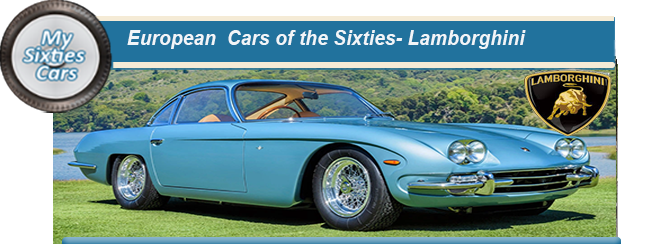
Ferruccio Lamborghini, founder of Lamborghini Motors, was born and raised in a small town close to Modena in the Emilia-Romagna region of northern Italy.
During those times, most of the residents of area earned their living from agriculture, although in later years, ironically, Modena would become the centre for quality car production in Italy, home to Ferrari and a few other companies. As a young man, Lamborghini displayed a tremendous interest in all things mechanical and became particularly adept in dismantling and repairing the most damaged or outmoded pieces of farming equipment. Any plans that Ferruccio had to pursue his talents through a formal education were put on hold when at the age of 24 he was conscripted into the Italian Army to play his part in World War Two.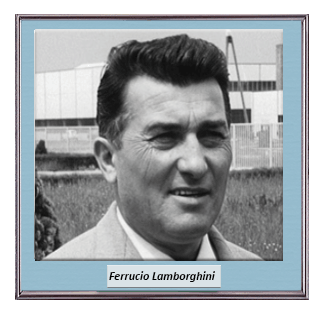 As fate would decree it, Lamborghini found himself stationed on the Greek Island of Rhodes, which had been occupied by Italy in 1940.
After a brief spell of fighting during the occupation, almost no military action happened on Rhodes, and those soldiers stationed on the island, Lamborghini included, found themselves with a lot of time on their hands.
Lamborghini’s talents as an improviser and mechanical repair expert were put to good use by his unit, repairing the broken down army equipment left on the island, using parts that the mostly reconditioned himself.
After the war, Lamborghini returned to Modena, a little older and a lot wiser, his head full of ideas on how to continue his career repairing vehicles of all sizes, from motorbikes to agricultural equipment.
As fate would decree it, Lamborghini found himself stationed on the Greek Island of Rhodes, which had been occupied by Italy in 1940.
After a brief spell of fighting during the occupation, almost no military action happened on Rhodes, and those soldiers stationed on the island, Lamborghini included, found themselves with a lot of time on their hands.
Lamborghini’s talents as an improviser and mechanical repair expert were put to good use by his unit, repairing the broken down army equipment left on the island, using parts that the mostly reconditioned himself.
After the war, Lamborghini returned to Modena, a little older and a lot wiser, his head full of ideas on how to continue his career repairing vehicles of all sizes, from motorbikes to agricultural equipment.
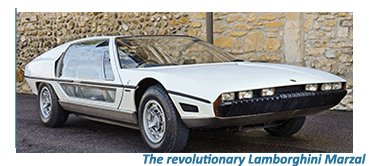 With brand new spare parts in very short supply, Lamborghini soon found himself once again scouring the countryside of Northern Italy looking for used parts to recondition.
Most of the parts that he found came from wrecked military vehicles, as the Emilia-Romagna region had been the scene of some heaving fighting, particularly towards the cessation of hostilities.
Lamborghini drew the rapid conclusion that most of these parts would only lend themselves to the repair and restitution of agricultural equipment, in particular tractors.
With brand new spare parts in very short supply, Lamborghini soon found himself once again scouring the countryside of Northern Italy looking for used parts to recondition.
Most of the parts that he found came from wrecked military vehicles, as the Emilia-Romagna region had been the scene of some heaving fighting, particularly towards the cessation of hostilities.
Lamborghini drew the rapid conclusion that most of these parts would only lend themselves to the repair and restitution of agricultural equipment, in particular tractors.
![]()
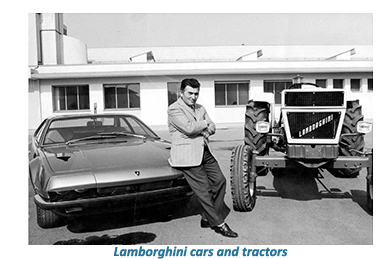 of the Fifties, Lamborghini had grown to become among the largest producers of tractors in Italy, with an annual production of around five thousand units.
Having reached the conclusion that he had grown his tractor business to its maximum level, the ever-active Ferruccio, still only in his early Forties, began to look to other industry sectors where he could operate.
The first was producing industrial heaters and air conditioning systems for factories which again proved to be very successful, increasing Lamborghini's already considerable wealth and standing in the business community even further.
Despite being renowned as a notorious workaholic, Lamborghini also knew how to enjoy his wealth. One of his particular indulgences was to own and drive the cream of the luxury sports cars that Italy could produce, with a particular leaning towards Ferraris, which, after all, were built in the town of Modena where he was born.
According to car industy folklore, sometime during the early Sixties, Lamborghini found himself in the company of the Enzo Ferrari.
of the Fifties, Lamborghini had grown to become among the largest producers of tractors in Italy, with an annual production of around five thousand units.
Having reached the conclusion that he had grown his tractor business to its maximum level, the ever-active Ferruccio, still only in his early Forties, began to look to other industry sectors where he could operate.
The first was producing industrial heaters and air conditioning systems for factories which again proved to be very successful, increasing Lamborghini's already considerable wealth and standing in the business community even further.
Despite being renowned as a notorious workaholic, Lamborghini also knew how to enjoy his wealth. One of his particular indulgences was to own and drive the cream of the luxury sports cars that Italy could produce, with a particular leaning towards Ferraris, which, after all, were built in the town of Modena where he was born.
According to car industy folklore, sometime during the early Sixties, Lamborghini found himself in the company of the Enzo Ferrari.
![]()
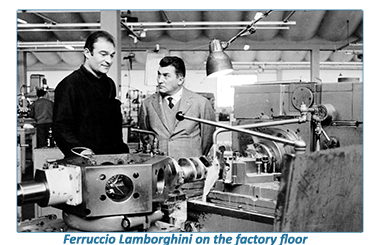 Not one for making light conversation, Lamborghini began to point out to Ferrari some of the faults that he had found with his Ferrari, and even suggest how to put them right.
Apparently Ferrari, who also had a short fuse, “ amicably” suggested to Ferruccio Lamborghini that if he thought he could do better, he should try. A challenge that the tractor magnate took literally.
Whether this charming story is true or not has never been confirmed. What is for sure is that a lot of midnight oil was being burnt at Lamborghini from the end of 1962.
By the summer of the following year ‘ Automobili Ferruccio Lamborghini’ had been registered, and a large parcel of land acquired about 25 kilometres from Bologna in the Emilia-Romagna region of northern Italy.
It was there that Lamborghini planned to build his new state of the art car production plant.
Just as he had scoured the countryside of Italy less than twenty years previously looking for parts, this time around Lamborghini scoured the design workshops and production plants to assemble the most elegant design and production team to get his new production team.
The critical task of developing the all-important V12 engine for the first Lamborghini model was handed to Giotto Bizzarrini, responsible for the design of some of the best drive trains for Ferrari.
Not one for making light conversation, Lamborghini began to point out to Ferrari some of the faults that he had found with his Ferrari, and even suggest how to put them right.
Apparently Ferrari, who also had a short fuse, “ amicably” suggested to Ferruccio Lamborghini that if he thought he could do better, he should try. A challenge that the tractor magnate took literally.
Whether this charming story is true or not has never been confirmed. What is for sure is that a lot of midnight oil was being burnt at Lamborghini from the end of 1962.
By the summer of the following year ‘ Automobili Ferruccio Lamborghini’ had been registered, and a large parcel of land acquired about 25 kilometres from Bologna in the Emilia-Romagna region of northern Italy.
It was there that Lamborghini planned to build his new state of the art car production plant.
Just as he had scoured the countryside of Italy less than twenty years previously looking for parts, this time around Lamborghini scoured the design workshops and production plants to assemble the most elegant design and production team to get his new production team.
The critical task of developing the all-important V12 engine for the first Lamborghini model was handed to Giotto Bizzarrini, responsible for the design of some of the best drive trains for Ferrari.
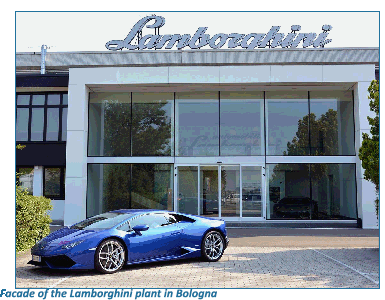 Design and production for the new plant was in the hands of Giampaolo Dallara and Giampaolo Stanzani, shortly after later joined by New Zealand-born Bob Wallace, a formidable team who played a considerable part in Lamborghini’s success during the Sixties.
Lamborghini was an uncompromising taskmaster who demanded the highest of standards from his employess.
Typically he set his team a challenging deadline to get the first Lamborghini, the 350 GTV- to be ready for unveiling at the Turin Auto Show, opening in November of 1963.
Less than six months after the new car plant went into operation, teething pains and all.
To their great credit, the Lamborghini team made the deadline, even with time to spare.
When the first Lamborghini was unveiled at the Turin Show, motoring correspondents from around opened their mouths in amazement at first sight of the new car.
Not just that it had been created in such a short time, but that it was such a good looker, with technical capacities that rivalled if not surpassed Automobili Lamborghini’s larger and longer-established competitors.
Not only was the 350 GTV well-received critically, but the Italian car-buying public also gave it their seal of approval with more than 130 sold.
Design and production for the new plant was in the hands of Giampaolo Dallara and Giampaolo Stanzani, shortly after later joined by New Zealand-born Bob Wallace, a formidable team who played a considerable part in Lamborghini’s success during the Sixties.
Lamborghini was an uncompromising taskmaster who demanded the highest of standards from his employess.
Typically he set his team a challenging deadline to get the first Lamborghini, the 350 GTV- to be ready for unveiling at the Turin Auto Show, opening in November of 1963.
Less than six months after the new car plant went into operation, teething pains and all.
To their great credit, the Lamborghini team made the deadline, even with time to spare.
When the first Lamborghini was unveiled at the Turin Show, motoring correspondents from around opened their mouths in amazement at first sight of the new car.
Not just that it had been created in such a short time, but that it was such a good looker, with technical capacities that rivalled if not surpassed Automobili Lamborghini’s larger and longer-established competitors.
Not only was the 350 GTV well-received critically, but the Italian car-buying public also gave it their seal of approval with more than 130 sold.
Following up on consumer and media feedback, Automobili Lamborghini pushed up the power considerably, with the launch of the 400 GT as well as improving passenger comfort dramatically with the release of 2+2 versions of both models.
The response to these two new models was way above everyone’s expectations, although they would fade into insignificance the following year compared to the tumultuous response for the Lamborghini Miura when launched in 1966, at the Geneva Show. While the 350 GTV had been relatively unspectacular in appearance, the Miura was an exercise in beauty as well as technologically advanced, making it the undoubted star of the show. With the launch of Miura, Automobili Lamborghini made the point that they were there to stay, going on to emphasise their point entirely the following year when they presented their full range of five cars, the 350 GT, 400 GT, Espada, Islero and Miura at Turin.
By that time the Lamborghini plant in Bologna was working at full capacity with hundreds of new cars produced annually.
Auto historians will tell you that the Sixties was the golden period for Automobili Lamborghini, putting them on the map in the luxury sports sector. The Seventies would prove much more challenging, with sales being severely affected by the dramatic rise in fuel and the subsequent global economic downturn.
Possibly se
With the launch of Miura, Automobili Lamborghini made the point that they were there to stay, going on to emphasise their point entirely the following year when they presented their full range of five cars, the 350 GT, 400 GT, Espada, Islero and Miura at Turin.
By that time the Lamborghini plant in Bologna was working at full capacity with hundreds of new cars produced annually.
Auto historians will tell you that the Sixties was the golden period for Automobili Lamborghini, putting them on the map in the luxury sports sector. The Seventies would prove much more challenging, with sales being severely affected by the dramatic rise in fuel and the subsequent global economic downturn.
Possibly se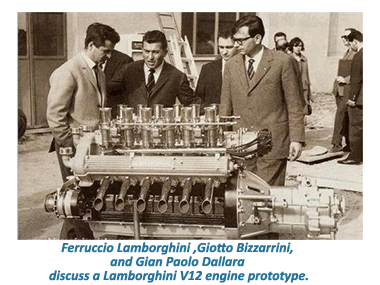 nsing that he had already witnessed the halcyon days for his car production enterprise, Ferruccio Lamborghini called it quits on his association with the company in the mid-Seventies, as part of a process that saw him gradually divest all of his interests in the industry.
Shocking as it may have been to many industry observers, this dynamic and hard-driven entrepreneur who had not reached the age of Sixty, returned to his hometown of Modena, investing a part of the massive fortune he had accumulated in the farming industry, where he still had considerable roots.
The one-time high profile entrepreneur was content to live out the rest of his days in anonymity, passing away at the ripe old age of 90.
nsing that he had already witnessed the halcyon days for his car production enterprise, Ferruccio Lamborghini called it quits on his association with the company in the mid-Seventies, as part of a process that saw him gradually divest all of his interests in the industry.
Shocking as it may have been to many industry observers, this dynamic and hard-driven entrepreneur who had not reached the age of Sixty, returned to his hometown of Modena, investing a part of the massive fortune he had accumulated in the farming industry, where he still had considerable roots.
The one-time high profile entrepreneur was content to live out the rest of his days in anonymity, passing away at the ripe old age of 90.






